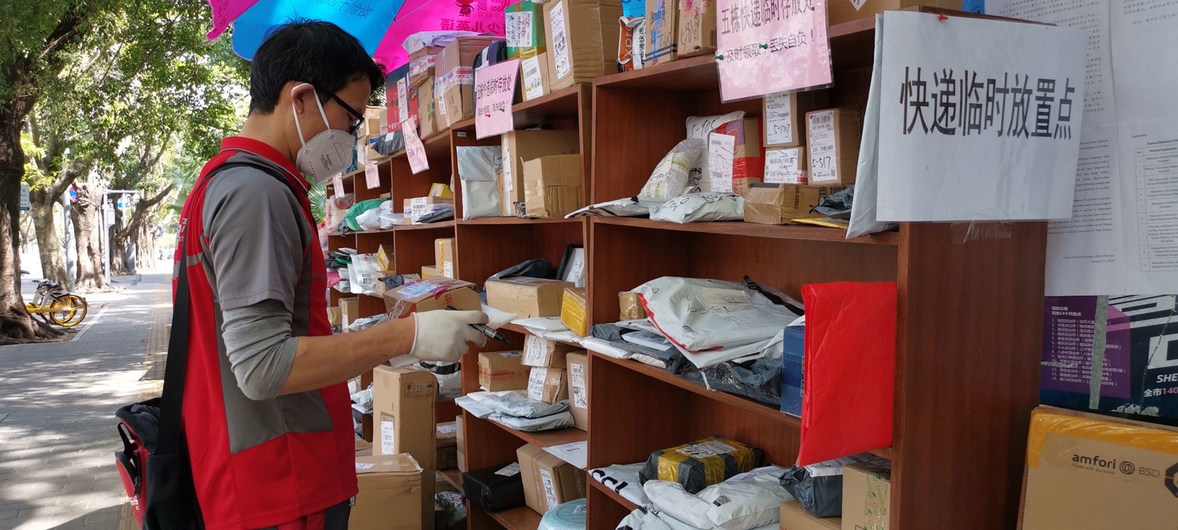COVID-19: More new virus cases outside China than in, ‘no time for complacency’, says UN health agency
The number of new COVID-19, or coronavirus, infections outside China has outpaced those inside the country for the first time, according to the World Health Organization (WHO).
“The sudden increases of cases in Italy, the Islamic Republic of Iran and the Republic of Korea are deeply concerning”, WHO Director-General Tedros Adhanom Ghebreyesus said at a briefing in Geneva on Wednesday.

A messenger leaves packages at an outdoor drop-off location as he is not allowed to enter buildings during the coronavirus outbreak in China.
He stated that there are now cases linked to Iran in Bahrain, Iraq, Kuwait and Oman and to Italy in Algeria, Austria, Croatia, Germany, Spain and Switzerland.
“Yesterday, a joint team between WHO and the European Centre for Disease Prevention and Control arrived in Rome to review the public health measures that have been put in place and provide technical support”, he informed, saying that over the weekend a
WHO team will travel to Iran to provide support.
One of the biggest challenges the UN health agency faces is that too many affected countries are still not sharing data with WHO.
“WHO cannot provide appropriate public health guidance without disaggregated data and detailed line lists”, said Mr. Ghebreyesus. “We’re communicating with ministers directly, there is some improvement, and we urge all countries to share this data with WHO immediately”.
Not a pandemic
The increase in cases outside China has prompted some media and politicians to push for a pandemic to be declared.
“We should not be too eager to declare a pandemic without a careful and clear-minded analysis of the facts”, he maintained, reminding that WHO has already declared it highest level of alarm: a public health emergency of international concern.
“Using the word pandemic carelessly has no tangible benefit, but it does have significant risk in terms of amplifying unnecessary and unjustified fear and stigma, and paralyzing systems”, he explained. “It may also signal that we can no longer contain the virus, which is not true”.
The head of WHO maintained that the fight can be won “if we do the right things”.
While affirming that “we will not hesitate to use the word pandemic if it is an accurate description of the situation”, Mr. Ghebreyesus said that WHO is monitoring the epidemic around the clock and engaging internal and experts on this issue and has witnessed “no sustained and intensive community transmission” of this virus, nor “large-scale severe disease or death”.
Prepare for the worst
China has fewer than 80,000 cases in a population of 1.4 billion people. In the rest of the world, there are 2,790 cases, in a population of 6.3 billion.
“Do not mistake me”, he said, “I am not downplaying the seriousness of the situation, or the potential for this to become a pandemic…every scenario is still on the table”.
The WHO chief spelled out: “The primary objective of all countries with cases must be to contain the virus”, and “all countries, whether they have cases or not, must prepare for a potential pandemic”.
Every country needs to be ready to detect cases early, to isolate patients, trace contacts, provide quality clinical care, prevent hospital outbreaks, and prevent community transmission. And WHO is providing tools to prepare, accordingly.
“This is no time for complacency”, he underscored. “This is a time for continued vigilance”.
WHO-China joint mission
As of Wednesday morning, China had reported 78,190 cases to WHO, including 2,718 deaths and reported only 10 new cases outside of Hubei province.
The results of a WHO-China joint mission to assess the rapidly evolving epidemic revealed a range of findings about the transmissibility of the virus, the severity of disease and the impact of the measures taken.
Having traveled to several different provinces, including Wuhan, the epicenter of the outbreak, the team found that the epidemic peaked and plateaued between the 23 January and 2 February, and has been declining steadily since then.
“They have found that there has been no significant change in the genetic makeup of the virus”, said Mr. Ghebreyesus. “The team also estimate that the measures taken in China have averted a significant number of cases”.
While the report contains a wealth of other information and includes 22 recommendations, the WHO chief said, “the key message that should give all countries hope, courage and confidence is that this virus can be contained”.
Source: United Nations
- 265 reads
Human Rights
Ringing FOWPAL’s Peace Bell for the World:Nobel Peace Prize Laureates’ Visions and Actions

Protecting the World’s Cultural Diversity for a Sustainable Future

The Peace Bell Resonates at the 27th Eurasian Economic Summit

Declaration of World Day of the Power of Hope Endorsed by People in 158 Nations

Puppet Show I International Friendship Day 2020

